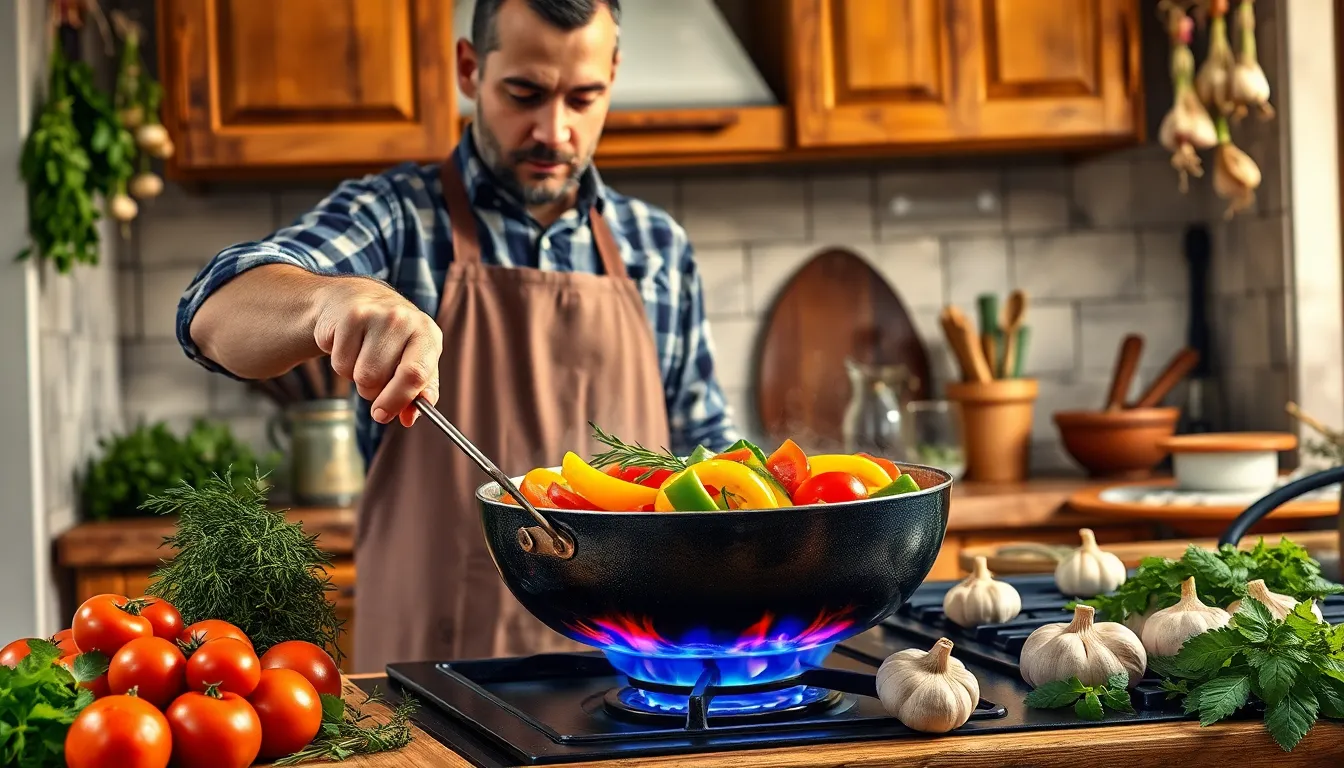Table of Contents
ToggleItalian cooking isn’t just a meal; it’s a love affair with flavors, aromas, and techniques that have been perfected over centuries. From the rolling hills of Tuscany to the bustling streets of Naples, every region boasts its own culinary secrets. Whether it’s the art of making fresh pasta or the science behind a perfect risotto, mastering these techniques can transform any home cook into a kitchen maestro.
Overview Of Italian Cooking Techniques
Italian cooking techniques encompass a variety of methods that elevate dishes through simplicity and depth of flavor. Emphasis on fresh ingredients showcases the quality of each element in the dish. Traditional methods include sautéing, simmering, and baking.
Sautéing serves as a foundational technique, highlighting the importance of cooking ingredients quickly over high heat. This method retains flavors and nutrients, especially when utilizing fresh herbs and vegetables. Simmering allows for a gentle melding of flavors in sauces, soups, and stews, creating rich, comforting dishes.
Baking remains essential in Italian cuisine, with techniques like slow-roasting and pizza-making drawing on different regional traditions. Risotto, a staple in Northern Italy, requires a specific technique of toasting rice and gradually adding broth.
Grilling offers a distinct layer of flavor, particularly with meats and vegetables, that reflects Italy’s outdoor dining culture. Braising, often used for tougher cuts of meat, breaks down fibers and infuses robust flavors into the dish.
Moreover, pasta-making stands as a revered art. Kneading dough to achieve the right texture requires skill and attention, resulting in homemade pasta that elevates any dish.
Understanding these techniques leads to a greater appreciation of Italian culinary arts. Each method contributes to the overall experience, emphasizing flavor and tradition passed down through generations. Using these techniques enriches home cooking with authenticity and creativity.
Key Cooking Methods

Italian cooking methods focus on enhancing the natural flavors of ingredients. These techniques elevate dishes while ensuring a connection to culinary traditions.
Sautéing
Sautéing involves cooking food quickly in a small amount of oil over high heat. This method allows ingredients to retain their flavors and textures. Common tasks include cooking vegetables or searing meats. Many chefs value sautéing for its versatility. Fresh garlic and herbs often accompany this technique, adding depth to various dishes. For example, sautéed vegetables can serve as a base for pasta or a side dish.
Braising
Braising combines both dry and wet cooking methods. It starts with browning meat at high heat, followed by slow cooking in a covered pot with liquid. This process tenderizes tougher cuts of meat and infuses them with rich flavors. Many Italian dishes, like osso buco, showcase this technique’s effectiveness. This method also works well for hearty vegetables, allowing all ingredients to meld beautifully. As a result, braised dishes offer a comforting meal option, perfect for family gatherings.
Grilling
Grilling plays a significant role in Italian cuisine, especially during summer gatherings. This method imparts a smoky flavor to meats, vegetables, and even fruits. Charcoal or wood-fired grills are preferred for their unique flavor profiles. Marinades made of olive oil, vinegar, and herbs enhance grilled foods, providing tantalizing aromas. Grilled bruschetta and skewers of vegetables reflect Italy’s outdoor cooking culture. This technique encourages simplicity, focusing on the quality of ingredients and hands-on preparation.
Essential Ingredients
Essential ingredients form the backbone of Italian cooking. They reflect the diversity and richness of the country’s culinary landscape.
Herbs and Spices
Basil ranks among the most important herbs used in Italian cuisine. Commonly found in sauces and salads, it provides a fresh, aromatic quality. Oregano contributes a robust flavor, often utilized in pizzas and tomato-based dishes. Parsley acts as a garnish and adds brightness to various plates. Garlic is vital in many preparations, infusing dishes with its distinctive essence. Lastly, red pepper flakes deliver heat and enhance flavor profiles in many regional recipes. These herbs and spices elevate dishes while maintaining the authenticity of Italian cooking.
Common Vegetables
Tomatoes are essential for many Italian sauces, offering sweetness and acidity that balances flavors. Eggplant features prominently in dishes like Melanzane alla Parmigiana, delivering a unique texture. Bell peppers add color and crunch in various preparations, including pasta and antipasti. Zucchini serves as a versatile ingredient in summer dishes, bringing lightness to meals. Onions form the base for countless sauces, enriching the overall taste. The combination of these vegetables emphasizes fresh, seasonal produce, integral to Italian culinary philosophy.
Regional Variations
Italian cooking showcases diverse regional techniques that highlight unique ingredients and flavors across the country. Northern and Southern Italy exhibit distinct approaches influenced by local climates and traditions.
Northern Italy Techniques
In Northern Italy, the focus shifts to creamy sauces and rich flavors. Risotto, a staple dish, requires slow stirring and gradual addition of broth for optimal texture. Polenta, made from cornmeal, serves as a hearty base for various toppings. Charcuterie also plays a significant role, with specialties like bresaola and prosciutto di San Daniele showcasing skilled curing techniques. Furthermore, Northern chefs often employ techniques like baking and braising, enhancing dishes with deep, savory flavors that reflect the region’s agricultural bounty.
Southern Italy Techniques
Southern Italy brings vibrancy with its focus on fresh vegetables and bright flavors. Techniques emphasize simplicity, often highlighting sautéing and roasting methods. Fresh tomato sauce, a cornerstone of cuisine, emerges from using just a few ingredients to allow natural flavors to shine. Grilling seafood reflects the coastal influence, capturing dynamic tastes through minimal seasoning. Moreover, pasta-making traditions thrive here, with shapes like orecchiette and cavatelli crafted by hand. Overall, the Southern approach celebrates local ingredients and straightforward methods that result in rich, satisfying meals.
Italian cooking techniques offer a gateway to a world rich in flavor and tradition. By embracing these methods home cooks can transform simple ingredients into extraordinary meals. The emphasis on fresh produce and regional specialties ensures that every dish tells a story rooted in history and culture.
Mastering techniques like sautéing and braising not only enhances culinary skills but also deepens the appreciation for the artistry behind Italian cuisine. As cooks explore the diverse regional variations they’ll discover the beauty of simplicity and the joy of sharing meals made with love. Whether it’s perfecting pasta or experimenting with seasonal vegetables the journey through Italian cooking is as rewarding as the meals themselves.





